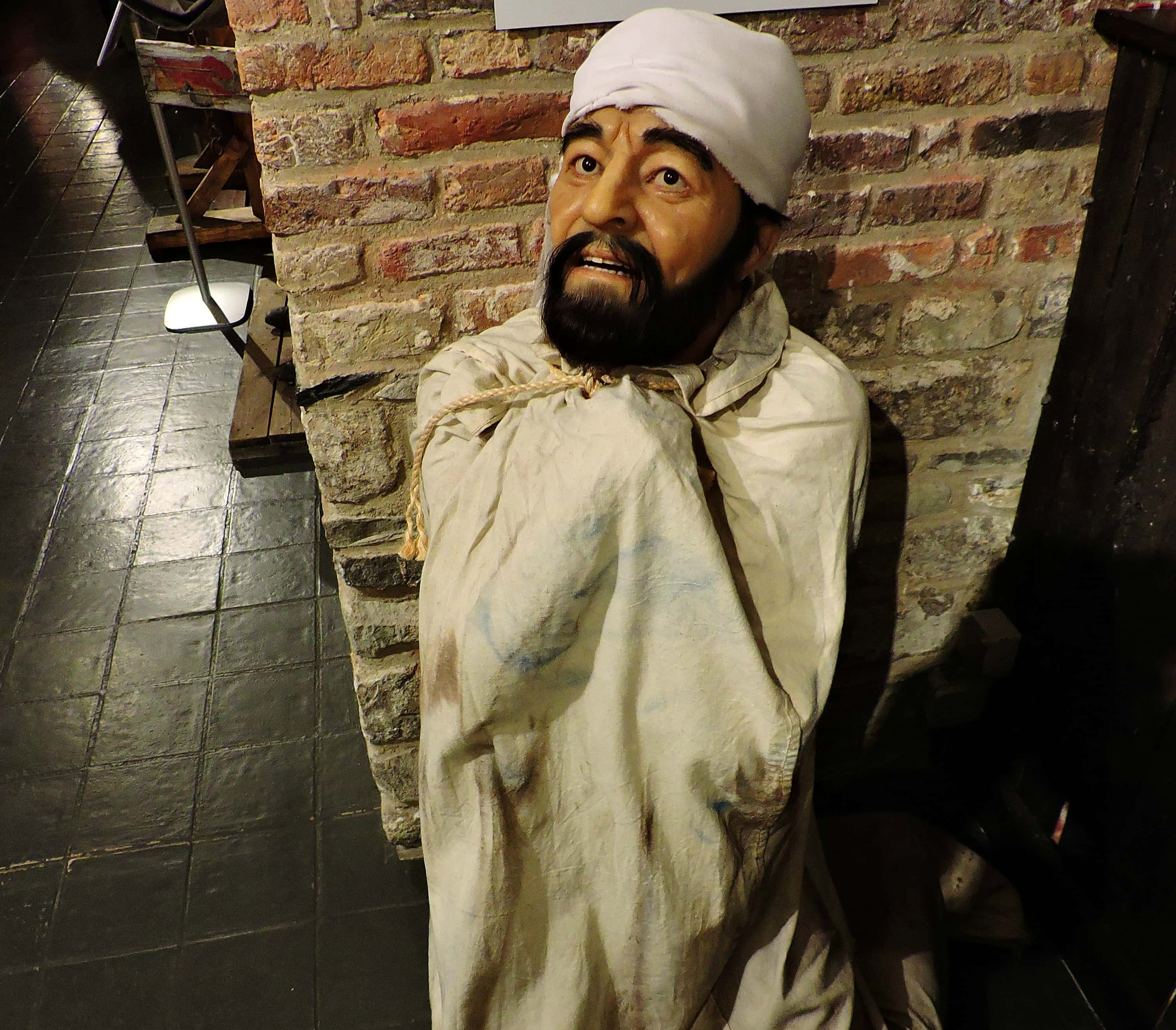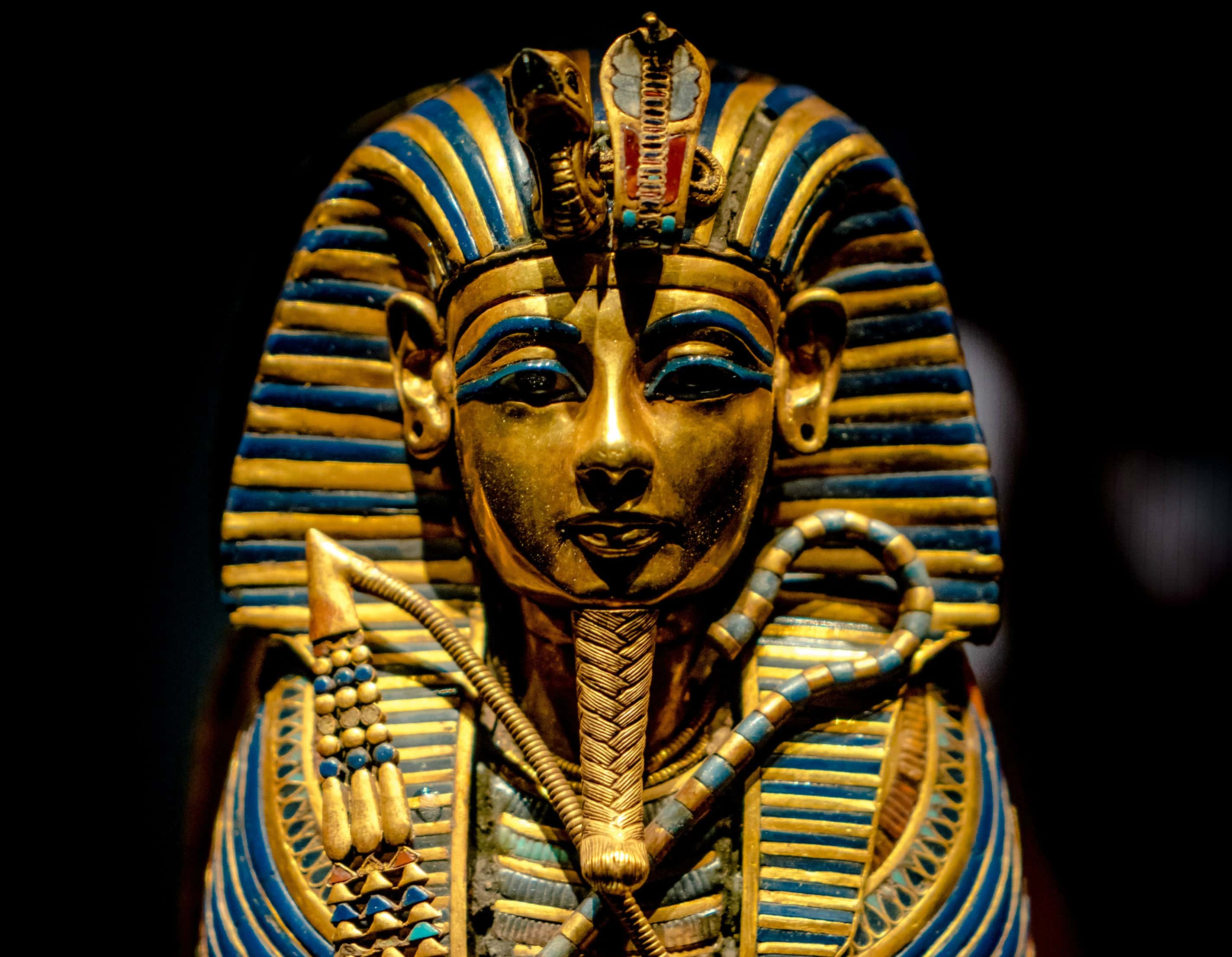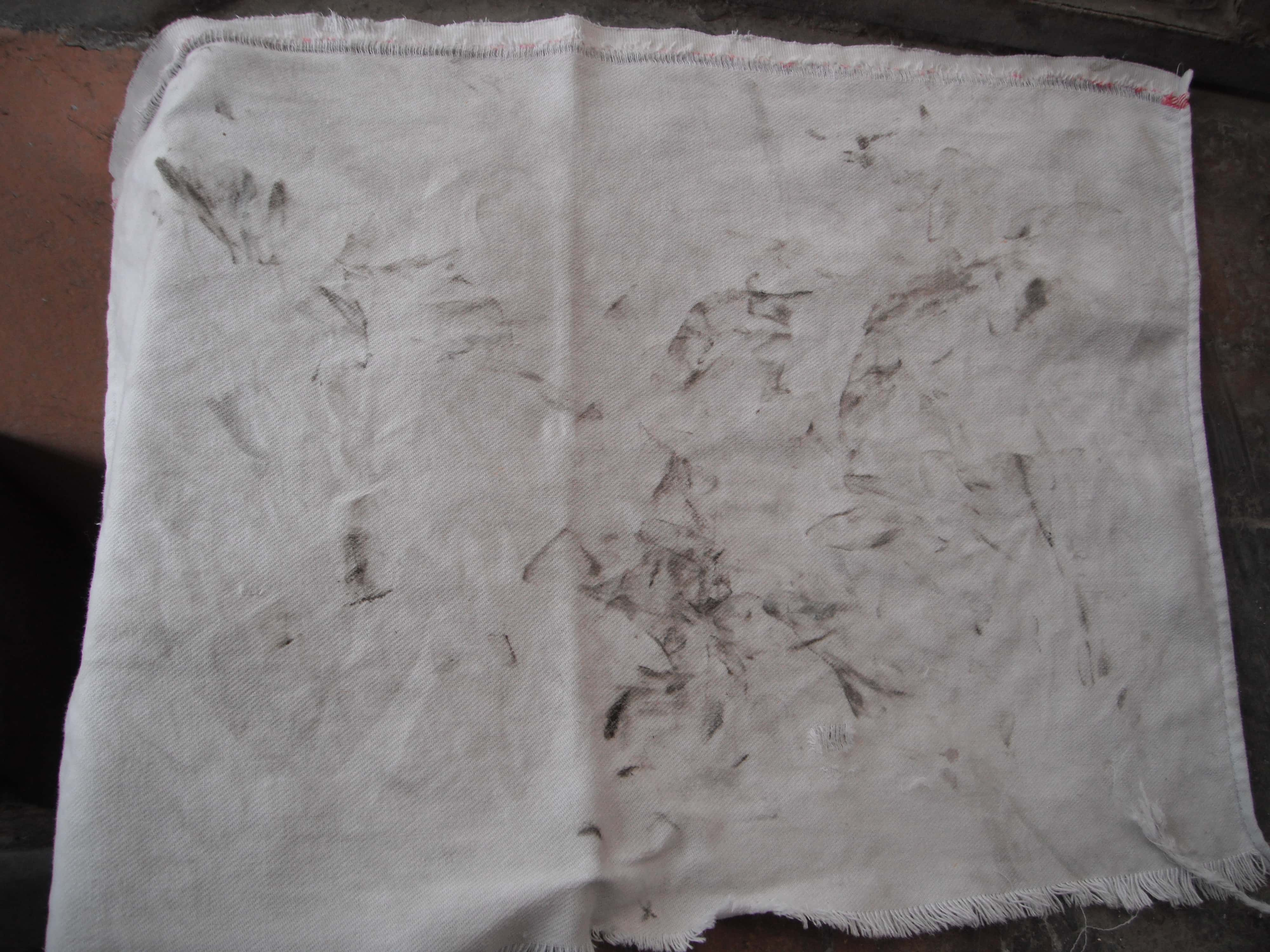Thanks to glossy period dramas and slick Hollywood epics, when we think of the past, it's easy to imagine gorgeous rulers and Pinterest-worthy palaces. But trust us, that's not how people really experienced life. From brutal punishments to nasty “medicines" and bizarre bedroom activities, it turns out that people have been gross forever.
1. Golden Cure
Urine was believed to be a great antiseptic. It was certainly good enough for Henry VIII’s surgeon, who abided by a policy that all battle wounds should be rinsed with the stuff. What’s more twisted? It wasn’t a terrible idea when you consider the alternatives; clean water was hard to come by in the Medieval Ages. Might as well use what you got.

2. The Oldest Joke in the Book
The first joke ever documented was about flatulence. It goes all the way back to 1900 BC and proves that potty humor is eternal.
3. Was the Penalty Appropriate for the Offense?
Marcus Aurelius (largely known for his philosophy and humanitarianism) faced an interesting gladiator dilemma. His wife Faustina became aroused over one combatant and confessed her passion to her husband. His solution? Faustina was instructed to disrobe and share a bed with the gladiator in question, who then tragically lost his life while positioned over her. Afterward, she was obliged to bathe in his blood, do a quick cleanup, and then make love to her husband Marcus.
4. Mad as a Hatter
Boston Corbett, the man who shot John Wilkes Booth, was totally insane from handling mercury as a hatter. Years prior to harming Booth, he calmly castrated himself with scissors.

5. Mortality Images
In the Victorian era, it was commonplace to have photographs taken of cherished ones post their departure from life. Families in Victorian Britain would even take photos with their deceased loved ones, often featuring children appearing to be asleep and young ladies seemingly reclining. This practice was particularly popular among children who did not survive. Yikes.
6. This’ll Kill Your Appetite
Many medieval saints were reputed to have healing powers, and they often cared for lepers and those afflicted with similarly gruesome diseases—by licking their wounds. St. Mary Magdalene of De’Pazzi licked the sores of the ill, and even sucked maggots out of wounds. St. Angela of Foligno drank water she had used to bathe a leper’s feet, and purposely swallowed one of his scabs.
7. Down to the Bone
In the Czech Republic, there is a church called The Sedlec Ossuary that has decorations made entirely of human bones. This happened because there were too many people in the cemetery to bury everyone, and the church leaders claimed that if their bones became part of the church, it only made them closer to God. Nice propaganda spin there, guys.
8. Horrible Protein Smoothies
In the 1600s, alchemists were extremely into finding eternal life, and they came up with some pretty disgusting theories and supposed elixirs along the way. One such alchemist, John French, used to prepare a "brain tincture," if you can guess what that was made of. He then left the mixture to sit inside of horse manure for six months, until it transformed into a liquid suitable for consumption. The worst thing of all? French had plenty of other colleagues trying out similar medicine.
9. When "Til Parting Isn't Enough for Us"
When Philip of Burgundy met his end, his wife Joanna refused to let him go. Literally. Refusing to part with her philandering husband, she viciously clung to the body. Even when her father and the government intervened to finally inter Philip, their separation was brief. Joanna commanded that he be unearthed, lunged towards his casket, and tenderly kissed his lifeless feet. And it only gets more disgusting from there...
10. Clingy Girl Problems
From that moment on, you couldn’t have Joanna if she couldn’t bring Philip. The coffin—thankfully closed most of the time—would accompany her to meals, travels, and even her bedside. Only years later did Philip return to the ground, albeit at a safe distance, i.e., buried right outside of her window. On the bright side, Joanna’s cheating husband was finally all hers!
11. X-Rated Creation
One Egyptian creation myth states that the universe was created when the god Atum, um, reached climax during private time. But that's not the gross part. To honor Atum, Pharaohs would ceremonially do the same thing...in public. They'd make a show of spreading their seed right into the Nile river.

12. Man-Made Miracles
Cannibalism wasn’t always a taboo. Medieval doctors kept their patients in check with drinkable byproducts of human blood and flesh. "Mummy powder" was a common item in 12th-century apothecaries, and these practices even had a unique title: "deceased individual's remedy." Continuing well into the 17th century, even English kings such as Charles II adhered to a unique health regimen which he termed "King's Drops." This consisted of an unusual mixture featuring crushed human skulls. Salty!
13. Don't Look a Gift Denture in the Mouth
In the 1800s, people needed dentures just like they do today—but they didn't have access to our modern technologies. Instead, dentures at that time were often crafted from the teeth of people who were no longer alive, particularly those who had served in combat roles.
14. Ballistic Remedies
Cheat on your diet with beaver testicles. In medieval times, beavers were classified as a breed of fish. As a result, consumption of beaver did not count as “eating meat” during a religious fast. Moreover, their furry private bits were very valuable in medicine recipes, a belief that gave birth to the myth that a beaver would bite its own testicles off and throw it at human hunters to escape with its own life.
15. A Warrior’s Blood
In ancient Rome, some people believed that if they drank fresh, warm blood from a fallen Gladiator, they would absorb their power. They also believed that drinking blood cured epilepsy.
16. A Little Pick-Me-Up
Nowadays we have Viagra, but Pliny the Elder suggested a bevy of ancient Roman aphrodisiacs that reads more like a witch’s shopping list than a doctor’s prescription. To put the pep back in your step, Pliny suggested the yolks of pigeon eggs, in honey, mixed with hog’s lard, or sparrows eggs, or a lizard drowned in one’s own urine.
17. Bleeding Awesome
Bloodletting was an important part of any medieval doctor’s belief system. A patient had two options: leeches or venesection. With the leeches, a “blood worm” would be administered on the pertinent body part and the creature would, in theory, suck the illness out. Sure, that sounds gross—but it's not as horrifying as the other option: the doctor would just slice open a vein with his “fleam” (razor) and hope for the best.
18. The Seven-Year Sniff
One day, the 17th Earl of Oxford entered Queen Elizabeth's courtroom, greeted her with a bow and awkwardly released a rather loud, disruptive noise. The man was duly mortified. So mortified, in fact, that he went into self-imposed exile for seven years. When he returned, Elizabeth's first response was, "My lord, I had forgotten the indiscretion."
19. And You Thought Buckley's Was Bad
The rule of thumb with medieval medicine was generally: if it does anything, then it's probably working. This led to many medicines that were actively bad for you. For instance, a common remedy for stomach worms would cause brutal diarrhea. Doctors presumed that the diarrhea signified the body was eliminating expired worms, when in fact, they were merely exacerbating an already dire situation.
20. Years Before Elmo Wanted Tickles…
Foot tickling was used in the Muscovite palaces and courts for centuries as a means of arousal. Many of the Czarinas (Catherine the Great, Anna Ivanovna, and others) loved it. In fact, it was so popular that eunuchs and women were employed as full time foot ticklers. While the ticklers performed their task, they often told bawdy stories and sang obscene ballads to get the ladies into the mood.

21. Profiting from Pee
In ancient Rome, human urine had a lot of applications and was a pretty valuable product, but Emperors Vespasian and Nero figured out a way to make a profit from people’s pee. They imposed a tax on acquiring urine, and Vespasian took things a step further, ordering public pay toilets to be built. The urine from the toilets was collected for tanning leather and cleaning clothes, though I have no idea how they kept the clothes from smelling like pee!
22. Splitting Pain
Medieval disciplinary techniques utilized basic instruments and the power of gravity to inflict inconceivable agony. The Judas Cradle was a pyramid-shaped spike that a victim would be forced to sit on, so that it penetrated their anus. As if that wasn't bad enough, torturers could strap weights to the feet of their victims to increase the suffering.
23. We Heart Mummies
When a body was mummified the brain was literally scrambled and removed through one of its nostrils, and each organ was placed in its own canopic jar. The only internal organ that was not removed was the heart as it was considered to be the seat of the soul.
24. Roman Restrooms
Unsurprisingly, considering how ancient Romans had multiple gods that had to do with sewers and poop, toilet etiquette was also pretty important to them as well. Public facilities had a long marble bench with holes on top—for the obvious thing—and holes at the front, to hold sponge-sticks called “spongias” that were the Roman equivalent of toilet paper. But there were a few very gross catches...
25. The More the Merrier
There were no doors or dividing walls in Roman bathrooms. You sat right next to your friend and did what you had to do. Once you had done your business, you would rinse the spongia in the channel of running water at your feet, give your bottom a solid wipe, rinse off the spongia… and leave it in a basin for the next person to use. Sharing is caring, people!
26. Born Numb
In the past, people thought babies were simply too underdeveloped to sense physical distress—and this led to a truly disturbing practice. Surgeries were regularly performed on infants without any attempt at anesthesia. Any crying was believed to be the result of ill-mannered childishness, as opposed to any external forces. Scary to think that “Babies feel pain” is a very recent belief.
27. Pelvic Finger Massage
Many women in Victorian England suffered from “hysteria,” which was really just a catch-all name for anything that bothered them. Feeling blue? Hysteria. Irritable? Hysteria. Anxious? Hysteria. How could you cure this horrible ailment? Well, a "pelvic finger massage" could induce a state of intense spasms. That is to say, having a doctor use his hands to cause a climax.
28. Electric Stimulator
Maybe it was their own fault for diagnosing basically every problem a woman had as hysteria, but either way, doctors could only perform so many “pelvic finger massages” a day before presumably beginning to battle Carpal Tunnel Syndrome themselves. Consequently, this particular device was the fifth domestic electronic invention ever created, preceding the electric vacuum cleaner, the electric iron, and the electric frying pan by almost ten years.
29. Cats And Dogs (And Snakes)
The Romans devised a punishment known as "Poena Cullei" to handle individuals who committed the act of parricide (ending their parents life). The offender was enclosed in a leather sack with a variety of wild creatures such as dogs, cats, snakes, and even monkeys; subsequently, this sack was tossed into a body of water. Eventually, the method fell out of practice, but was revived several times throughout history, each time with a specific list of animals to be thrown in the sack.
30. Filthy Composition
Surprisingly, Mozart had an obsession with bathroom humor and scatological jokes. Two of his songs actually talk about anlingus. He also wrote letters to his family members where he described his farts in great detail.

31. Heads Will Roll
Aztec gods and religion demanded more human sacrifices than any other faith in history. Priests would conduct these rituals at the Pyramids of the Sun and Moon. Approximately 500 to 700 lives were taken each year to placate the gods.
32. Royal Audience
On his wedding night, future king William of Orange consummated his marriage while Charles II watched from the sidelines and shouted encouragement.

Charles II.
33. That’s So Sweet
King Herod, the despotic ruler of Judea, maintained his wife, Mariamne I, in a state of preservation within honey following her demise. Mariamne was executed on her husband’s orders, but Herod found her too beautiful to be buried and kept her preserved body for seven years. Some even claimed Herod had er, relations, with the body.
34. Ouch.
In ancient Greece, “Figging” was the insertion of the skinned ginger root into one of the lower orifices to cause an intolerable burning sensation and discomfort.
35. Blast from the Past
In 1996, famous pirate Blackbeard’s ship, the Queen Anne’s Revenge, was found off the coast of North Carolina. Thirty-one cannons and 250,000 artifacts have been recovered. One such artifact was a urethral syringe, which was used to treat syphilis with mercury. Ouch. Plot twist: mercury does not, in fact, cure syphilis.
36. Frozen in Time
Madame Tussaud’s wax museum is famous around the world for frighteningly life-like figures of celebrities. What most people don’t know, however, is that Madame Anna Maria Tussaud got her start by rushing over to grab heads from the guillotine during the French Revolution. She used these heads to showcase her waxing process.
37. Crocodile Cure
In ancient times it was pretty common to use animal dung as a treatment or a cure for various diseases. In ancient Greece, crocodile poop was used as a female contraceptive, and in ancient Egypt, warriors used animal dung to treat battle wounds. Sheep droppings were used by the Scots to treat smallpox, and pig dung was used to stop nosebleeds. Thank goodness someone invented Kleenex!
38. Nail in the coffin.
During the 7th century B.C., ancient Roman "vestal virgins" were required to keep their hymens intact as proof of virginity until age 30. Vestal virgins involved in intimate behavior were buried alive.
39. Brain Food
Do you ever wonder what people did before the invention of assembly-line cups and bowls? In ancient England, people used the tops of hollowed human skulls to drink and eat.
40. Alone Time Isn’t Fun Time For Everyone
We imagine it was hard to offend those Ancient Greeks, but the quirky Diogenes put that to the test by pleasuring himself while inside of a barrel. Frequently. And in public. Diogenes defended his behavior by saying how he wished it was “as easy to relieve hunger by rubbing an empty stomach,” as if that counts as a defense.
41. Wash Your Brain and Your Hands
Adding to the list of Diogenes’ social faux pas, the philosopher was also (allegedly) known for pooping in public theatres and urinating on “annoying” people. Well, it takes one to know one, Diogenes.
42. No One Was Safe
The Aztec religion could be brutally literal at times. During periods of drought, priests would sacrifice children specifically, because they believed that the little ones' tears would bring rain. In 1980, archaeologists found the remains of 42 child skeletons near a large Aztec temple.
43. Disturbing Decapitations
One grisly aspect of Celtic culture was their obsession with severed heads. Since the Celts considered the head to be the source of life and the location of a person’s soul, warriors saw great value in beheading their defeated enemies. Not only that, but severed heads were a motif in Celtic art and Celtic mythology. Mythic figures such as the Green Knight would even carry their own severed heads in their hands while their mouths kept speaking!

44. Keep It in the Family
Ancient Egyptian King Tutankhamun, or as he is more affectionately known, King Tut, met his end at the tender age of 18. Some researchers believe his life came to an end from a genetic disease, directly traceable to the fact that his parents were siblings. Ancient Egypt was into Game of Thrones before it was cool.
45. Flatulence Humor = Timeless
King Henry II employed a professional "flatulist" named Roland the Farter.
46. Moss Definitely
Hundreds of years ago, when individuals perished on the battlefield or other outdoor locations, their bodies often remained undisturbed until decomposition occurred. As they decomposed, their skulls would start to grow a moss called usnea. People believed that this moss embodied the spiritual properties of those who had fallen in battle, and they would collect it for medicinal purposes. Apparently, usnea that grew on hanged men's skulls was seen as the most effective.
47. All in Favor of the Free Carrots Bill?
The Roman Emperor Gaius Caligula made his horse a senator. Caligula is also accused of engaging in inappropriate relationships with his sisters, feeding prisoners to wild animals, and having conversations with the moon.
48. I Ate His Liver With Some Fava Beans
Xipe Totec (meaning "Our Lord the Flayed One"), was the Aztec god of agriculture, vegetation, the east, disease, spring, goldsmiths, silversmiths, liberation, and the seasons. They believed that he flayed himself to provide food for humanity. As such, followers of the god wore the flayed skin of prisoners during worship.
49. No Political Movement Like a Bowel Movement
The infamous King Henry VIII employed four Grooms of the Stool, men whose job it was to wipe the royal bottom and attend to his other private needs. It was a position of great honor, but also—as one Groom soon discovered—incredibly grave danger. Henry VIII executed one of his bathroom staff, Sir Henry Norris, on trumped up charges that he was sleeping with Henry's second wife Anne Boleyn.
50. Bite Me
In ancient China, there was a process of making a “mellified man,” which was essentially mummifying someone with honey. To carry this out, an older individual, preferably in their advanced years, would willingly offer themselves to undergo being extensively bathed in honey, and be given only honey to consume, until their entire digestive system was filled with honey. Then, when the volunteer's life came to an end, they would be covered in honey for 100 years. After this century or so, the contents were turned into a candy that was said to heal broken bones.
51. Weird Flex
The mystic monk Rasputin went for incredibly long periods of time without touching himself or washing. He once bragged about not changing his underwear for over six months, and food would often rot in his beard. Despite these personal choices, a group of Russian women still venerated his intimate area.
52. I Prefer the Statue of Liberty
The Aztec's fondness for human sacrifice led to a truly horrific sort of public display. The "tzompantli," common across many different Mesoamerican cultures, was a massive skull rack meant to show off the skulls of sacrifices. Tenochtitlan alone had several of them, but the largest was in the massive Templo Mayor complex in the city's center. Archaeologists discovered this huge tzompantli in 2017, and it contained more than 650 skulls.
53. Don't Mess With King Phillip
When King Phillip IV of France (“Phillip the Fair”) discovered his three daughters-in-law were having intimate relations with knights from his court, he actually forced the girls to stand trial for adultery. The resulting scandal became the brutal Tour de Nesle affair. Ultimately, two of the daughters-in-law ended up with shaved heads and confined, but the fate of their lovers turned out to be much more severe.
Most historians agree that the lovers were first castrated and then either drawn and quartered or flayed alive, broken on a wheel and then hanged. Yikes.
54. Now You're Just Bragging
The Aztecs themselves reported that during the reconsecration of the Great Pyramid of Tenochtitlan, they sacrificed more than 80,000 prisoners in just four days.
55. Let it Out!
In the Ancient world, you’d probably be wise not to admit to having a headache among other things as doctors might attempt to cure you by drilling a hole in your head. The practice of trepanation was used to cure convulsions, headaches and infections, and doctors believed that they were caused by evil spirits being trapped inside your head that needed to be let out. An exorcism would probably have been less painful!
56. Sexy Signposts
You know how airport parking lots have special numbers and letters to help you recall where you parked your car? Well, Ancient Roman bathhouses had those too, except replace “car” with “toga” and “numbers and letters” with “sexually explicit images".
People would remember where they put their toga by remembering what “position” they hung it under. What was the alternative? Going to the toilet with their clothes on?
57. In One Ear…
One ancient Egyptian cure for blindness was to pour mashed-up pig’s eye into the patient’s ear. Luckily, patients who received this treatment couldn’t see the mess it made.
58. Accurate Representation
How would you like to be remembered after your lifetime? If you chose to be "like decaying remains," you would blend perfectly into the Medieval society. There was a type of tomb called ‘transi tombs’, which would display a sculpture of the deceased in an advanced state of decomposition, sometimes being eaten by snakes or other creatures.
59. Making Sure
Before the advent of modern medicine and technology, it was challenging to confirm if someone who seemed lifeless was truly devoid of life. So, of course, doctors came up with truly disturbing methods to make sure. Ways of checking included yanking out the deceased’s hair, breaking their fingers, and stabbing them with a needle. One medieval poem recounts Charlemagne biting his friend's toe in an effort to wake him up.
60. No Future
Ancient Egyptians practiced scatomancy, the act of predicting the future through someone's waste material. Well, if there’s anyone who can tell us about the future, it’s Doc Brown. We’ll see ourselves out.

61. Don’t Choke
Medieval methods of inflicting pain were just as horrific as the stereotypes would have us believe. One gruesome device was the choke pear, a metal contraption that torturers would insert into a victim’s orifices and then expand. I didn’t see that the last time I went to Medieval Times.
62. The individual responsible for the wrongdoing must endure the punishment.
If you were found guilty of adultery in ancient Greece, the husband of the woman with whom you were unfaithful had the right to subject you to humiliation with radishes.
63. Definitely a Turn-Off
Birth control was quite difficult in medieval times, though it was helped by the belief that the best time to conceive was during menstruation. Contraception methods included wearing the testicles of a weasel, the earwax or uterus of a mule, a bone from a black cat, or donkey dung around your neck. I mean, that’s one way to make a man keep his distance.
64. A Sticky Mixture
Specializing in enhancing intimate performance was a characteristic of the ancient Greeks, and one of their methods included applying a blend of honey and crushed pepper to their sensitive areas to ensure their arousal would last an extended period. Makes perfect sense!
65. Gotta Get Dirty to Get Clean
The ancient Romans did NOT have Tide or Crest, in case you were wondering. What was used to wash clothing in ancient Rome? Urine, of course. The Romans also used it to whiten their teeth. I'll pass, thanks.
66. Praying for a Good Poop
The inhabitants of ancient Rome had a sewer goddess, a toilet god, and a god of excrement. The gods were often depicted gathering in the latrine in significant numbers, with excrement being viewed as sustenance for those who have passed on.
67. You get a Sacrifice! And You get a Sacrifice! Everyone gets a Sacrifice!
It seems the Aztecs just couldn't get enough of sacrifice. They sacrificed adults, children, and animals, depending on which god they meant to please. Some priests would practice self-mutilation and offer up their own blood as a sacrifice. And finally, while it's unknown just how widespread this practice was, some Aztec rituals featured cannibalism.
68. Supper anyone?
15th century Romanian ruler Vlad the Impaler was the inspiration for Dracula and had a uniquely gross way of dealing with his opposition. He invited hundreds of them to a banquet and had them impaled on long sharp poles. His contemporaries reported that he also had a penchant for consuming the blood that dripped from of some of his victims, hence the Dracula connection.

69. Wagging Tails
It was a common belief that witches kept male genitalia as house pets, even going as far as to feed them and house them in nests. Puts a new spin on My Pet Rock, right?
70. A Chicken a Day
As you can imagine, the Black Plague and medieval medicine didn't exactly work well together. People had no idea what caused the disease, and even less of an idea what cured it—so they tried some truly insane remedies. Many people believed that pressing the shaved bottom of a live chicken against the boils of an infected person was the only solution. The only problem was that the chickens then also became infected and helped spread the disease.
71. Bore You Unbearably
Nothing gets earthier than a boar bile enema. Administered by “clysters”—large, long, metal syringes—they can’t have been a comfortable way to pump medicine in medieval subjects. But where they truly that awful? Louis XIV “The Sun King” of France had as many as 2,000 of these during his lifetime.
72. Cure You or Kill You
Some of the cures physicians used for the Black Plague actually made things worse: Doctors would burst plague boils, which only helped spread infection. Another treatment involved applying human excrement to the boils, which probably caused entirely new diseases in the victim, on top of the fact that they, you know, applied human excrement to plague boils.
73. The Ultimate Gross Revenge
Upon discovering his wife's infidelity, Peter the Great ensured the man's demise. But then, he escalated his revenge even further. He compelled his wife to preserve her lover's head in a jar of preservative liquid in her bedroom. The head, still in it’s jar, is now kept on display at the Kunstkamera museum in St. Petersburg.
74. Cutting It Close
Ling Chi, also known as the punishment by a thousand cuts, was a form of sentence carried out in ancient China. The executioner utilizes a blade to extract small portions of the victim's body, ultimately leading to their demise. Executioners would test their abilities by attempting to extend the torment for as long as possible. Seriously, cut it out.
75. Anatomically Correct
Ancient Egyptian doctors had specialties, often focusing on one part of the human body. Dentists were known as “doctors of the tooth,” while the term for proctologists literally translates to “shepherd of the anus". We don't want any part of that Shepherd’s Pie.
76. The Magic Touch
There was a belief in the Middle Ages that corpses retained a tiny spark of life and were therefore magical, which justified the practice of ‘cruentation’. For this, they would establish contact between an accused murderer and the lifeless body of their supposed victim. If spontaneous bleeding began from the deceased body, that confirmed the murderer's guilt. Cruentation was a legally valid practice and was used as late as the 17th century.
77. Too Sexy For My Tweezers
In ancient Greece, the unibrow was a sign of intelligence and great beauty in women. Some women who didn't have epic unibrows naturally used makeup to draw one on.
78. Gross is Where the Heart is
The author of Frankenstein, Mary Shelley, had a rather eerie secret tucked away in her desk: the preserved heart of her late husband. When her husband, the poet Percy Bysshe Shelley, drowned in a boating accident, he was cremated, but his heart remained intact. Physicians believe it might have been calcified due to tuberculosis. Regardless of the reason, Mary ultimately received it, and it was found in her desk a few years later, following the end of her life.

79. Royally Drop Where You Stop
The legendary Palace of Versailles had everything—except enough toilets for everybody. Despite the villa’s luxury, Versailles simply didn’t have enough public water closets to accommodate Louis XIV’s huge court. It wasn't uncommon for courtiers to offer each other incentives for access to those precious commodes... or else, they simply went in the corner.
At least this was better than the Princess d’Harcourt, who would often just urinate where she walked, which made her understandably hated by the servants. The aristocracy: they’re truly our betters.
80. Keeping Out the Riffraff
Today, if someone wants to keep out trespassers they build a fence or a wall, or maybe just get a guard dog, but in ancient Rome, they had a rather unique way of dealing with unwanted intruders. Statues of the god Priapus, complete with erect penises, were placed in market gardens throughout Rome. The Romans held a belief that Priapus would enforce stern intimate penalties on anyone intruding without consent, and whatever that implied, it proved to be a highly effective deterrent.
81. Head of the Army
King Goujian of Yue (reigned 496–465 BC) placed a row of convicted criminals at the front of his army. Before the battle, the criminals would cut off their own heads to scare his enemy’s army.
The Bronze Sword of Goujian, King of Yue State.
82. I Ain’t Lyein’
Who doesn’t love the smell of fresh, clean laundry? Medieval people, apparently. They washed their clothes with lye made from ash and human urine.
83. Paternal & Papal Invasions of Privacy
On October 2 1533, Pope Clement VII married Catherine de Medici off to the french Dauphin (the son of the King), Henri. The couple were lucky to be the same age—just 14 years old—but old men still wormed their way into the honeymoon. Henri’s father, King Francis I, apparently stayed in the bedroom until the marriage was fully consummated, and the Pope visited the couple in bed the next morning to bless the previous night’s “proceedings". Yick.
84. Fire to Go
Vikings often spent long voyages in unfamiliar territory, so they needed an effective way to create fires consistently. They did have a solution to this problem, but it was absolutely disgusting. They actually took a special fungus, cut it into slices, beat the slices so they had a felt-like texture… then boiled them in urine. These strips could hold an ember for days, but at what cost?
Sources: 1, 2, 3, 4, 5, 6, 7, 8, 9, 10, 11, 12, 13, 14, 15, 16, 17, 18, 19, 20 21, 22, 23, 24, 25, 26, 27, 28, 29, Reddit, 31, 32, 33. . 35. 36, 37, 38, 39, 40, 41, 42, 43, 44, 45, 46, 47, 48, 49, 50, 51, 52, 53, 54, 55, 56, 3, 57, 58, 59, 60, 61, 62, 63, 64, 65, 66, 67, 68, 69, 70, 71, 72, 73, 74, 75, 76, 77, 78, 79, 80, 81, 82, 83, 84, 85, 85, 86, 87, 88, 89, 90, 91, 92, 93, 94, 95, 96, 97, 98, 99, 100, 101, 102, 103, 104, 105, 106, 107, 108, 109, 110, 111 112, , 114

















































































